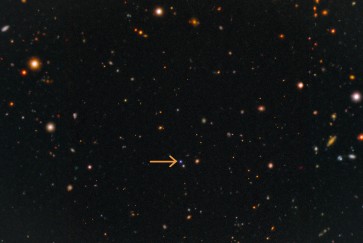A feature resembling a candy cane appears at the center of this colorful composite image of our Milky Way galaxy’s central zone. But this is no cosmic confection. Reaching 190 light-years tall, it is one of a set of long, thin, radio-emitting filaments, discovered by Northwestern University’s Farhad Yusef-Zadeh in the early 1980s.
This particular candy cane-shaped filament was recently detected by the Goddard-IRAM Superconducting 2-Millimeter Observer (GISMO), designed and built at NASA’s Goddard Space Flight Center in Greenbelt, Maryland. It marks the first time that astrophysicists have observed these structures with two-millimeter wavelengths.
The image combines archival infrared (blue), radio (red) and GISMO’s new microwave observations (green). The view spans a part of the sky about 1.6 degrees across — equivalent to roughly three times the apparent size of our moon — or about 750 light-years wide. The image reveals emission from cold dust, areas of vigorous star formation and relativistic particles of the magnetized filaments.
Known as the “Radio Arc,” the straight part of the candy cane is the most prominent radio filament in the galactic center. Yusef-Zadeh says the filaments delineate the edges of a large bubble produced by some energetic event near the Milky Way’s central black hole. An area called the Sickle may supply the particles responsible for setting the Radio Arc aglow.
Two papers describing this composite image were published last month in The Astrophysical Journal. One paper was led by the University of Maryland, Baltimore County and Goddard; the second was led by Johns Hopkins University. Yusef-Zadeh was a co-author of both papers.
— By Francis Reddy, NASA
Image credit: NASA’s Goddard Space Flight Center

